Roosia lucilleae
Roosia lucilleae (Van Jaarsv.) Van Jaarsv.
Family: Aizoaceae
Common names: Hex River cliff mesemb (Eng.); Heksrivier kransvygie (Afr.)
Introduction
One of two species belonging to the genus Roosia, endemic to sheer, quarzitic, sandstone cliff-faces in the heart of the winter-rainfall region of South Africa. It is small, branched, shrubby, leaf succulent recognized at once by its large, pink flowers with spreading, narrow petals and a fruiting capsules without cell lids, and seed that is dispersed by wind. The floral petals remain for some time, resembling a mop-head.
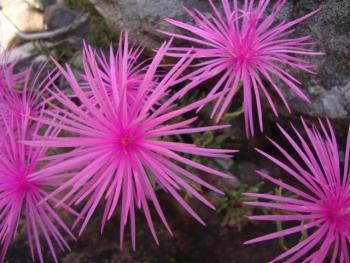
Description
Description
Roosia lucilleae plants are branched, ascending shrublets, 250–300 mm high, with fibrous roots. The main branch is woody, about 5 mm in diameter at the base, longitudinally fissured and with dark brown to blackish bark, the younger branches about 2.5 mm in diameter and glaucous; internodes are 5–20 mm apart, surface smooth. Leaves are fleshy, almost cylindrical (subterete) to somewhat compressed, linear-lanceolate, sickle-shaped, 22–34 × 2 mm, lateral sides 2.5 mm high; upper surface flat, lower surface rounded, surface glaucous green, minutely papillate; the leaf ends in a incurved point.
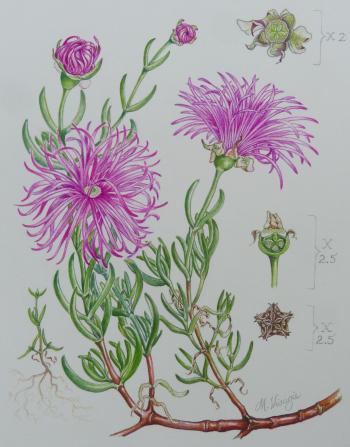
The solitary flowers are born on the branch ends, 70–80 mm in diameter, on pedicels 15–23 mm long. The floral base (receptacle) is top-shaped to rounded, 8 mm high and 8 mm in diameter at the top. The 5 sepals are, triangular-acuminate, unequal in length, the 3 inner with translucent margins, 8 × 4 mm; outer 3 triangular-acuminate, 12–16 × 4 mm. The petals (in 3 series, persistent after flowering) numerous, linear-lanceolate, ascending-spreading, rose- to cerise-pink, 35–40 × 1.5 mm, ending in a sharp point. The older flowers with the appearance of a mop-head. The floral filaments in about 3–4 series, 3 mm long, the base with dense, transparent hairs, 0.5 mm long. The anthers 1 × 0.3 mm yellowish to cream-coloured, not completely overtopping the female parts (stigmas). The flowers is convex at the top, 7 mm in diameter, with 5 raised sutures, green, surrounded by narrow, nectar glands surrounding the ovary. Stigmas 5, ascending, triangular, ending in sharp points, 2.5 mm long, arising from the sunken centre between the lobes, tapering. The capsule is 5-locular, hygroscopic, top-shaped, 7–8 mm in diameter, 5–7 mm deep; top rounded, open capsule up to 8–12 mm in diameter; valve wings and closing body absent, expanding keels about 2 mm long and 0.7 mm in diameter, parallel at base diverging widely, acute and incurved at the ends, once opened, the capsule remains open; covering membranes ascending. Seeds pear-shaped, 1.5 × 0.9 mm, reddish brown, tuberculate, flattened.
Flowering time is spring to early summer (October-November in the southern hemisphere).
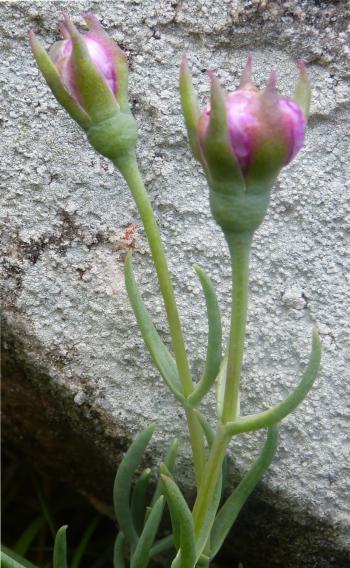
Conservation Status
Status
Roosia lucilleae is a rare species that is abundant on its cliff-face habitat and widespread in its range. The plants are well-protected by their sheer, mostly out of reach, cliff-face habitat and are thus not threatened. It has not yet been formally assessed for the Red List of South African Plants.
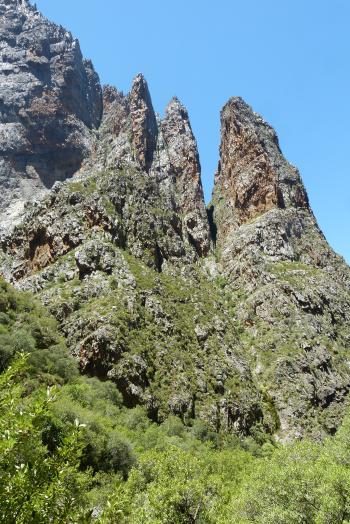
Distribution and habitat
Distribution description
Roosia lucilleae grows along the south-facing side of the Hex River Mountains near De Doorns and in deep gorges in an outlier population on the Stettynsberg Mountains, south-west of Worcester. It is a sub-alpine plant growing on mineral-poor, quartzitic, sandstone cliffs of the Table Mountain Series (Cape Supergroup), at altitudes ranging from about 1 000–1 700 m above sea level.
The vegetation in its habitat consists mainly of Southern Hex Sandstone Fynbos (Mucina & Rutherford 2006), which is part of the Fynbos Biome. This shrubby, fire-driven vegetation is extremely rich in species diversity and with high levels of endemism. The acidic soil is nutrient poor. The climate is summer dry and with cool to cold winters, often with snow. Rainfall is mainly in winter, ranging between 1 000 and 2 000 mm per annum.
Roosia lucilleae grows on ledges in shallow soil with moss and lichens and where fires rarely reach. The older plants often become pendent. At Dome Kloof, Groothoekskloof and Buffelshoekkloof, R. lucilleae grows with other succulents such as Aloe mitriformis, Crassula atropurpurea var. anomale, C. dentata, C. nudicaulis, C. obtusa and C. pellucida subsp. spongiosa, Haemanthus sp. and Haworthia arachnoidea (Van Jaarsveld & Visagie 2017).

Derivation of name and historical aspects
History
The genus Roosia was established by the author in the British Succulent Journal, Bradleya, in 2017 to accommodate the 2 known species, R. lucilleae and R. grahambeckii (Van Jaarsveld 2011b, Van Jaarsveld & Visagie 2017). The latter 2 species were previously accommodated in the genus Esterhuysenia (Herre 1975), however, distinct differences in vegetative, floral and fruiting capsule, ensured their position in the newly established genus Roosia. The genus name is in honour of Mrs Karen Roos, owner of the Babylonstoren Farm, near Paarl in the Drakenstein Valley, who sponsored my exploration and research on southern African succulent plants growing on cliff faces. Also for the rose-pink flowers (rose = roos in Afrikaans).
This specific epithet lucilleae, is named for Mrs Lucille Krige, a keen mountaineer and observer of succulent plants who brought this species to the author's attention, which led to its description in the Flowering Plants of Africa (Van Jaarsveld 2017). During October 2013, she sent me a photo of a mesemb in flower found by her and Tom Faure at Dome Kloof in the Hex River Mountains. Its distinctness was immediately realised and an expedition was arranged to its habitat, beginning of November 2013. The original site was reached and upon investigation, I realized it was possibly the same species that I had collected (only in fruit), earlier that year, from the Groothoekskloof, as well as yet an earlier collection by Mrs Anso le Roux (ecologist and botanist from the Farm Pokkraal, near Rawsonville), when she brought me cuttings from a plant collected from cliffs at Stettynsberg Mountains, south-west of Worcester. Because of the cooler flowering requirements, these plants did not flower and their true identity was only recently established when the habitat was visited during their flowering period.
When in flower, both species of Roosia reminds one of Lampranthus affinis, which also has soft leaves and large, pink flowers and grows on mineral-poor sandstone cliffs from the Klein Karoo to the Baviaanskloof in the Eastern Cape. However, here the resemblance ends, as L. affinis has different flowers and fruiting capsules.
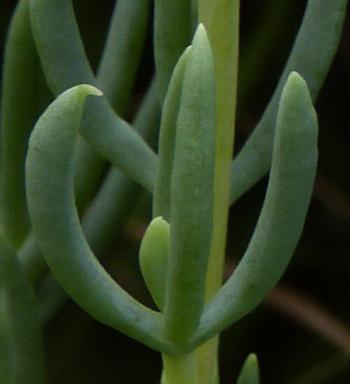
Ecology
Ecology
Roosia lucilleae is adapted to grow in a climate with hot, dry summers and cool, moist winters. The glaucous, softly succulent leaves have a powdery bloom, which aids during the long dry summers. The cliffs are often in cloud in summer because of the prevailing southeasterly winds. The bright rose-pink to pink flowers appear in October and November and are pollinated by insects. The fruiting capsules ripens in summer. However, the capsules only open after the first rainfall (usually in autumn) and they then remain open. The flattened seeds are dispersed by wind and water. The seeds germinate on ledges often among moss and lichens, where the plants become established. Most mesembs have capsules which open when they become wet, and close again when becoming dry; thus they tend to conserve the seeds, rather than shedding them all at once. By contrast, the capsules of R. lucilleae remain open once they have opened and seeds are shaken out and dispersed by wind.
Uses
Use
No cultural uses have been recorded for Roosia lucilleae.
Growing Roosia lucilleae
Grow
Roosia lucilleae grows well in cultivation, but unfortunately, at lower altitudes where the climate is hotter, it does not readily flower. However, in cooler regions of the Western Cape and similar climate elsewhere in fynbos, they will flower in spring, providing a beautiful show. It is best to grow R. lucilleae in cool fynbos gardens on steep embankments, dry stone walls or hanging baskets (Van Jaarsveld 2010). The plant grows fairly rapidly from cuttings and should flower the same year. Plants react well to ample organic fertilizer, such as seagro. Plants can remain in the same container for a number of years. Pests include the tiger moth caterpillars which are destructive. It is easily controlled by hand or by spraying or dusting with a contact pesticide.
Plants grow easily from cuttings (5–10 cm length) or seed sown in a sandy mixture in a coarse gravel or sandy soil, in late autumn. Cover the seed with a thin layer of sand (1–2 mm thick) and keep moist and in a sunny situation. Germination is within 3 weeks and plants should be able to flower in the third year.
References
- Herre, H. 1971. The genera of the Mesembryanthemaceae. Tafelberg, Cape Town.
- Mucina, L. & Rutherford, M.C. (eds) 2006. The vegetation of South Africa, Lesotho and Swaziland. Strelitzia 19. South African National Biodiversity Institute, Pretoria.
- Van Jaarsveld, E.J. 2010. Water wise gardening. Struik, Cape Town.
- Van Jaarsveld, E.J. 2011. Cremnophilous succulents of southern Africa: diversity, structure and adaptations. Unpublished Ph.D.Thesis, University of Pretoria.
- Van Jaarsveld, E.J. 2011. Esterhuysenia grahambeckii, a new rare species in the Aizoaceae (Mesembryanthema, Ruschioideae) from the Rooiberg, Western Cape South Africa. Bradleya 29: 43–50.
- Van Jaarsveld, E.J. 2017. Roosia: A new genus in the Aizoaceae. Bradleya 35: 150–158.
- Van Jaarsveld, E.J. & Van Wyk, A.E. 2003. Adaptations without barriers: succulent plants shaped by cliffs. Aloe 40: 98–103.
- Van Jaarsveld, E.J. & Visagie, M. 2017. Esterhuysenia lucilleae. Flowering Plants of Africa 65: 96–105.
Credits
Ernst van Jaarsveld
Kirstenbosch National Botanical Garden (Retired)
Babylonstoren Farm
Extraordinary senior lecturer and researcher, Department of Biodiversity and Conservation, University of the W. Cape.
October 2017
Plant Attributes:
Plant Type: Shrub, Succulent
SA Distribution: Western Cape
Soil type: Sandy
Flowering season: Spring
PH: Acid
Flower colour: Pink
Aspect: Full Sun
Gardening skill: Average
Special Features:
Horticultural zones








Rate this article
Article well written and informative
Rate this plant
Is this an interesting plant?
Login to add your Comment
Back to topNot registered yet? Click here to register.